Data Analytics and Business Intelligence Literature Review System04104
VerifiedAdded on 2022/11/25
|5
|1779
|227
Literature Review
AI Summary
This literature review examines the application of predictive analytics and business intelligence across six major companies: Amazon, Wal-Mart, Google, McDonald's, General Motors, and Apple Inc. It explores how these organizations leverage data mining, data modeling, and other analytical techniques to make future predictions and gain a competitive edge. The review highlights the use of big data, machine learning, and artificial intelligence by companies like Amazon and Google to analyze customer behavior, predict demand, and personalize services. It also discusses the specific tools and techniques employed, such as cloud computing, data mining platforms, and AI-driven personalization, providing insights into how predictive analytics supports strategic decision-making and enhances business outcomes. The review concludes by emphasizing the importance of predictive analytics in identifying future trends and mitigating risks through the analysis of historical and real-time data.
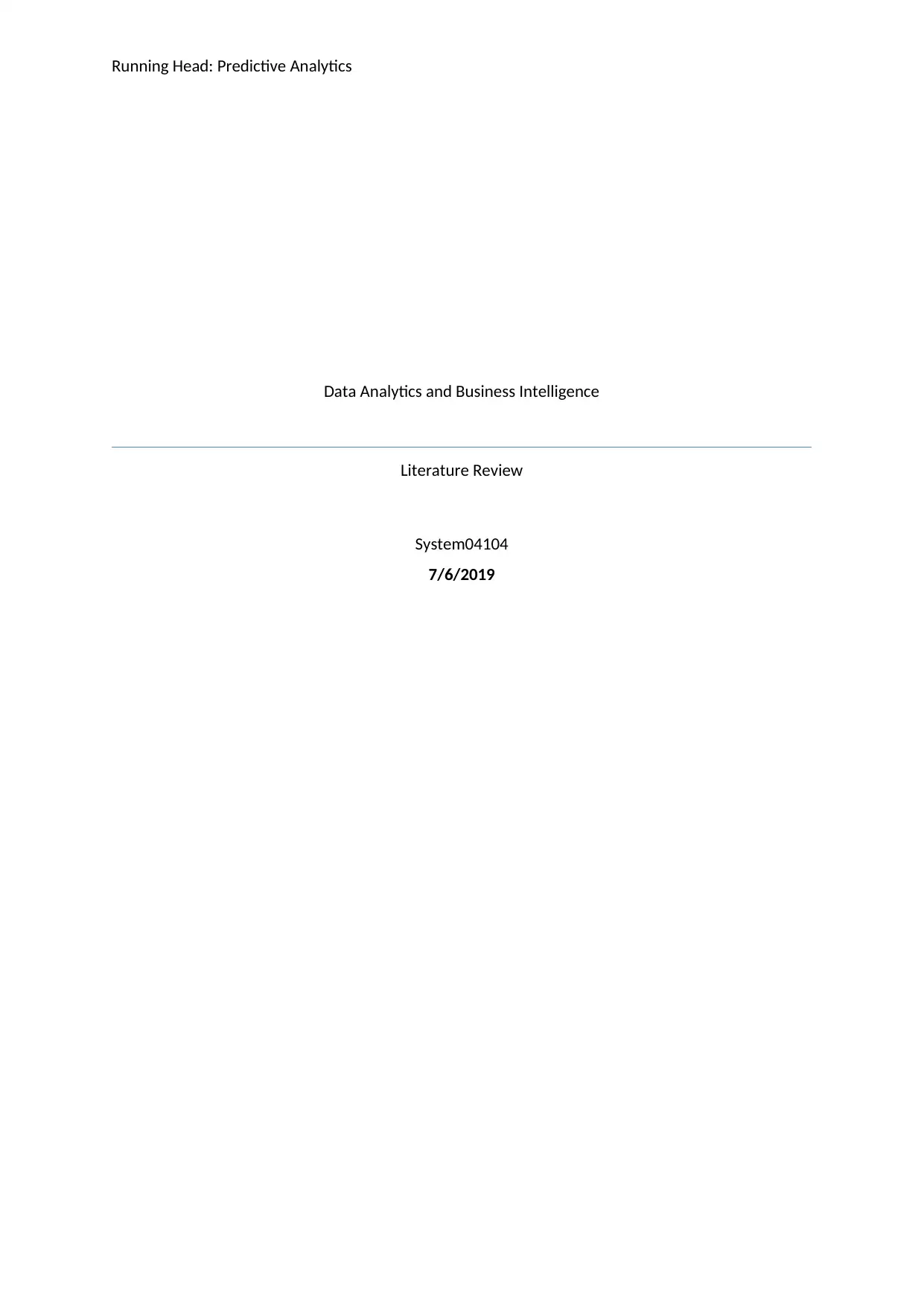
Running Head: Predictive Analytics
Data Analytics and Business Intelligence
Literature Review
System04104
7/6/2019
Data Analytics and Business Intelligence
Literature Review
System04104
7/6/2019
Paraphrase This Document
Need a fresh take? Get an instant paraphrase of this document with our AI Paraphraser
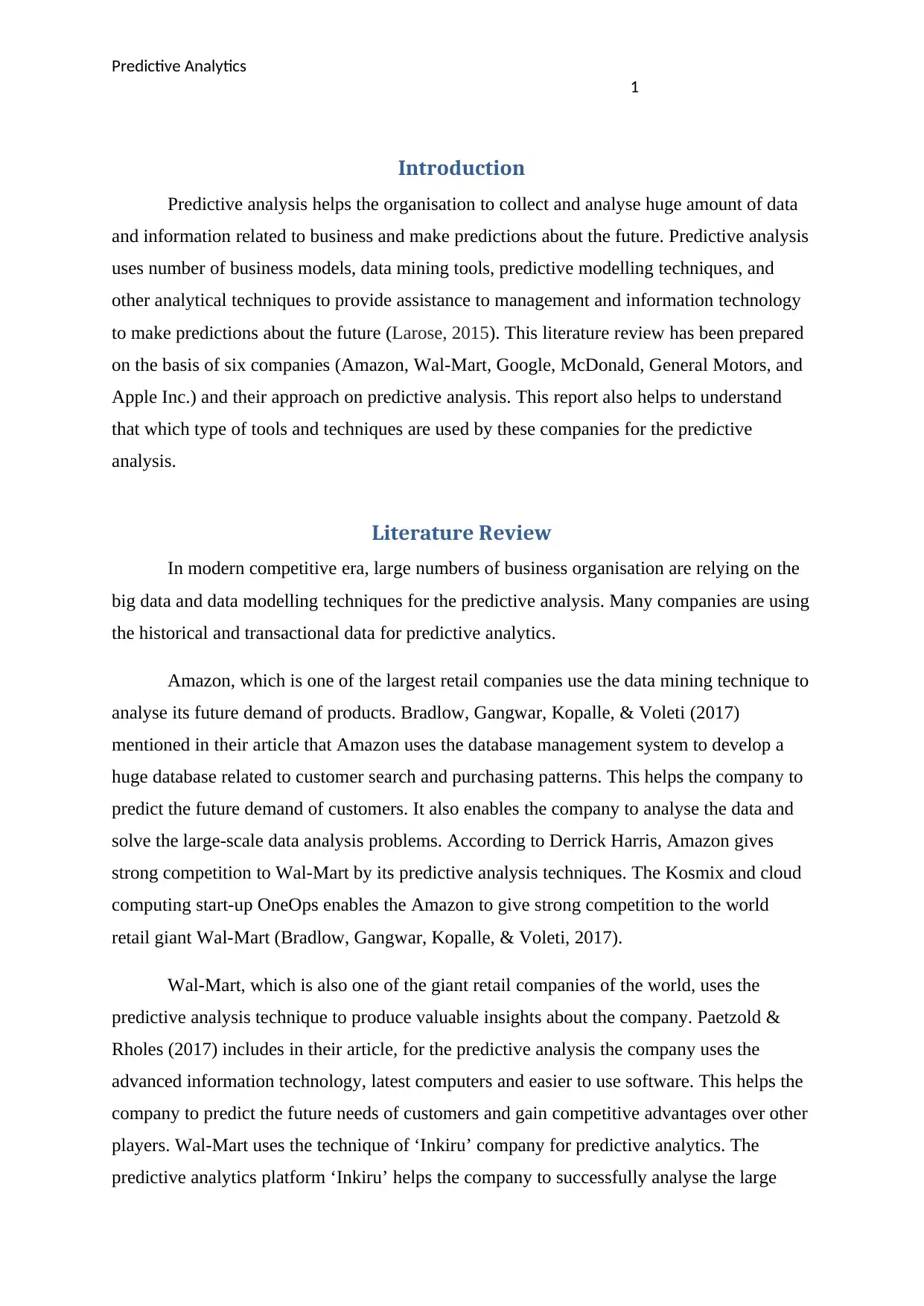
Predictive Analytics
1
Introduction
Predictive analysis helps the organisation to collect and analyse huge amount of data
and information related to business and make predictions about the future. Predictive analysis
uses number of business models, data mining tools, predictive modelling techniques, and
other analytical techniques to provide assistance to management and information technology
to make predictions about the future (Larose, 2015). This literature review has been prepared
on the basis of six companies (Amazon, Wal-Mart, Google, McDonald, General Motors, and
Apple Inc.) and their approach on predictive analysis. This report also helps to understand
that which type of tools and techniques are used by these companies for the predictive
analysis.
Literature Review
In modern competitive era, large numbers of business organisation are relying on the
big data and data modelling techniques for the predictive analysis. Many companies are using
the historical and transactional data for predictive analytics.
Amazon, which is one of the largest retail companies use the data mining technique to
analyse its future demand of products. Bradlow, Gangwar, Kopalle, & Voleti (2017)
mentioned in their article that Amazon uses the database management system to develop a
huge database related to customer search and purchasing patterns. This helps the company to
predict the future demand of customers. It also enables the company to analyse the data and
solve the large-scale data analysis problems. According to Derrick Harris, Amazon gives
strong competition to Wal-Mart by its predictive analysis techniques. The Kosmix and cloud
computing start-up OneOps enables the Amazon to give strong competition to the world
retail giant Wal-Mart (Bradlow, Gangwar, Kopalle, & Voleti, 2017).
Wal-Mart, which is also one of the giant retail companies of the world, uses the
predictive analysis technique to produce valuable insights about the company. Paetzold &
Rholes (2017) includes in their article, for the predictive analysis the company uses the
advanced information technology, latest computers and easier to use software. This helps the
company to predict the future needs of customers and gain competitive advantages over other
players. Wal-Mart uses the technique of ‘Inkiru’ company for predictive analytics. The
predictive analytics platform ‘Inkiru’ helps the company to successfully analyse the large
1
Introduction
Predictive analysis helps the organisation to collect and analyse huge amount of data
and information related to business and make predictions about the future. Predictive analysis
uses number of business models, data mining tools, predictive modelling techniques, and
other analytical techniques to provide assistance to management and information technology
to make predictions about the future (Larose, 2015). This literature review has been prepared
on the basis of six companies (Amazon, Wal-Mart, Google, McDonald, General Motors, and
Apple Inc.) and their approach on predictive analysis. This report also helps to understand
that which type of tools and techniques are used by these companies for the predictive
analysis.
Literature Review
In modern competitive era, large numbers of business organisation are relying on the
big data and data modelling techniques for the predictive analysis. Many companies are using
the historical and transactional data for predictive analytics.
Amazon, which is one of the largest retail companies use the data mining technique to
analyse its future demand of products. Bradlow, Gangwar, Kopalle, & Voleti (2017)
mentioned in their article that Amazon uses the database management system to develop a
huge database related to customer search and purchasing patterns. This helps the company to
predict the future demand of customers. It also enables the company to analyse the data and
solve the large-scale data analysis problems. According to Derrick Harris, Amazon gives
strong competition to Wal-Mart by its predictive analysis techniques. The Kosmix and cloud
computing start-up OneOps enables the Amazon to give strong competition to the world
retail giant Wal-Mart (Bradlow, Gangwar, Kopalle, & Voleti, 2017).
Wal-Mart, which is also one of the giant retail companies of the world, uses the
predictive analysis technique to produce valuable insights about the company. Paetzold &
Rholes (2017) includes in their article, for the predictive analysis the company uses the
advanced information technology, latest computers and easier to use software. This helps the
company to predict the future needs of customers and gain competitive advantages over other
players. Wal-Mart uses the technique of ‘Inkiru’ company for predictive analytics. The
predictive analytics platform ‘Inkiru’ helps the company to successfully analyse the large
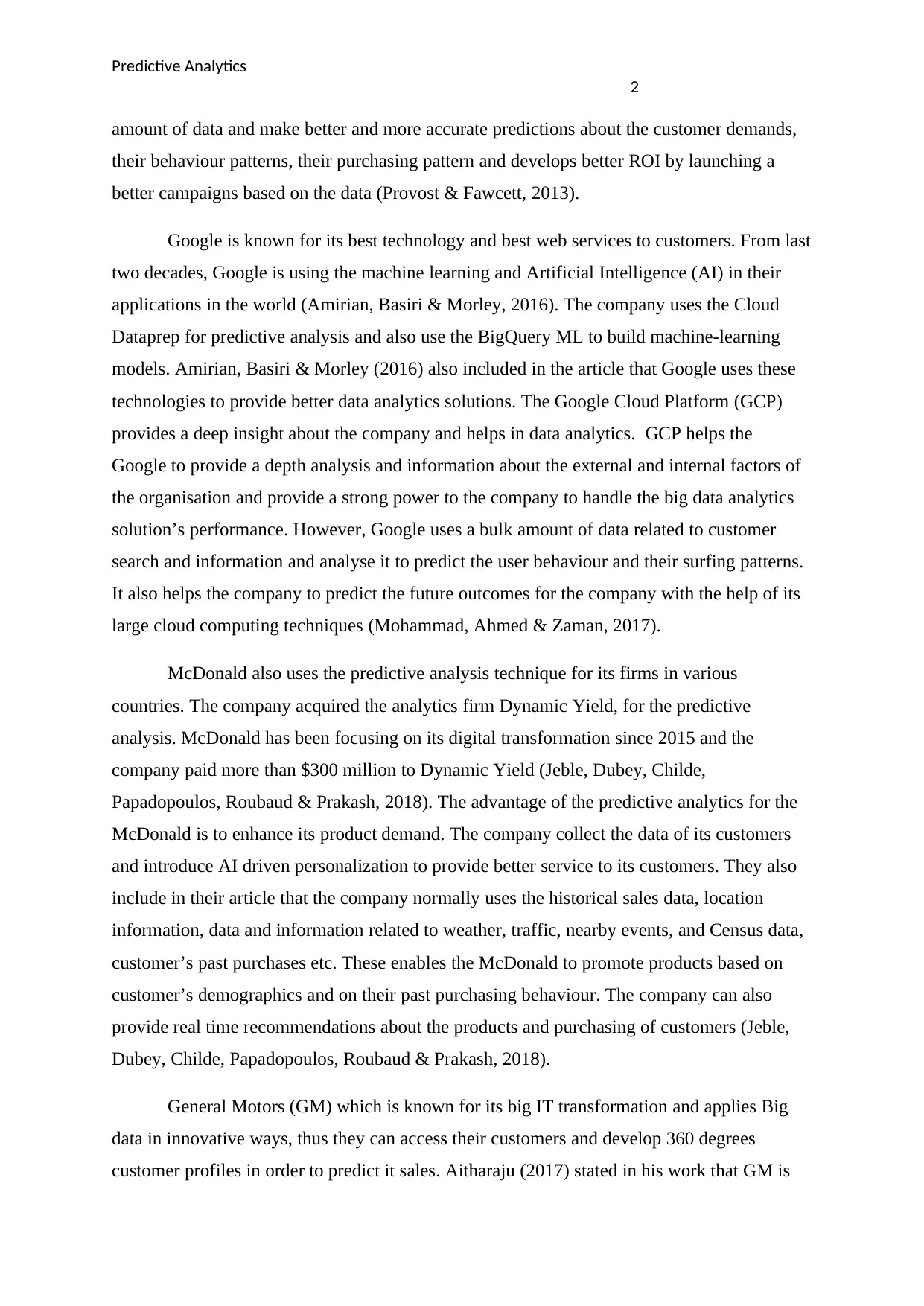
Predictive Analytics
2
amount of data and make better and more accurate predictions about the customer demands,
their behaviour patterns, their purchasing pattern and develops better ROI by launching a
better campaigns based on the data (Provost & Fawcett, 2013).
Google is known for its best technology and best web services to customers. From last
two decades, Google is using the machine learning and Artificial Intelligence (AI) in their
applications in the world (Amirian, Basiri & Morley, 2016). The company uses the Cloud
Dataprep for predictive analysis and also use the BigQuery ML to build machine-learning
models. Amirian, Basiri & Morley (2016) also included in the article that Google uses these
technologies to provide better data analytics solutions. The Google Cloud Platform (GCP)
provides a deep insight about the company and helps in data analytics. GCP helps the
Google to provide a depth analysis and information about the external and internal factors of
the organisation and provide a strong power to the company to handle the big data analytics
solution’s performance. However, Google uses a bulk amount of data related to customer
search and information and analyse it to predict the user behaviour and their surfing patterns.
It also helps the company to predict the future outcomes for the company with the help of its
large cloud computing techniques (Mohammad, Ahmed & Zaman, 2017).
McDonald also uses the predictive analysis technique for its firms in various
countries. The company acquired the analytics firm Dynamic Yield, for the predictive
analysis. McDonald has been focusing on its digital transformation since 2015 and the
company paid more than $300 million to Dynamic Yield (Jeble, Dubey, Childe,
Papadopoulos, Roubaud & Prakash, 2018). The advantage of the predictive analytics for the
McDonald is to enhance its product demand. The company collect the data of its customers
and introduce AI driven personalization to provide better service to its customers. They also
include in their article that the company normally uses the historical sales data, location
information, data and information related to weather, traffic, nearby events, and Census data,
customer’s past purchases etc. These enables the McDonald to promote products based on
customer’s demographics and on their past purchasing behaviour. The company can also
provide real time recommendations about the products and purchasing of customers (Jeble,
Dubey, Childe, Papadopoulos, Roubaud & Prakash, 2018).
General Motors (GM) which is known for its big IT transformation and applies Big
data in innovative ways, thus they can access their customers and develop 360 degrees
customer profiles in order to predict it sales. Aitharaju (2017) stated in his work that GM is
2
amount of data and make better and more accurate predictions about the customer demands,
their behaviour patterns, their purchasing pattern and develops better ROI by launching a
better campaigns based on the data (Provost & Fawcett, 2013).
Google is known for its best technology and best web services to customers. From last
two decades, Google is using the machine learning and Artificial Intelligence (AI) in their
applications in the world (Amirian, Basiri & Morley, 2016). The company uses the Cloud
Dataprep for predictive analysis and also use the BigQuery ML to build machine-learning
models. Amirian, Basiri & Morley (2016) also included in the article that Google uses these
technologies to provide better data analytics solutions. The Google Cloud Platform (GCP)
provides a deep insight about the company and helps in data analytics. GCP helps the
Google to provide a depth analysis and information about the external and internal factors of
the organisation and provide a strong power to the company to handle the big data analytics
solution’s performance. However, Google uses a bulk amount of data related to customer
search and information and analyse it to predict the user behaviour and their surfing patterns.
It also helps the company to predict the future outcomes for the company with the help of its
large cloud computing techniques (Mohammad, Ahmed & Zaman, 2017).
McDonald also uses the predictive analysis technique for its firms in various
countries. The company acquired the analytics firm Dynamic Yield, for the predictive
analysis. McDonald has been focusing on its digital transformation since 2015 and the
company paid more than $300 million to Dynamic Yield (Jeble, Dubey, Childe,
Papadopoulos, Roubaud & Prakash, 2018). The advantage of the predictive analytics for the
McDonald is to enhance its product demand. The company collect the data of its customers
and introduce AI driven personalization to provide better service to its customers. They also
include in their article that the company normally uses the historical sales data, location
information, data and information related to weather, traffic, nearby events, and Census data,
customer’s past purchases etc. These enables the McDonald to promote products based on
customer’s demographics and on their past purchasing behaviour. The company can also
provide real time recommendations about the products and purchasing of customers (Jeble,
Dubey, Childe, Papadopoulos, Roubaud & Prakash, 2018).
General Motors (GM) which is known for its big IT transformation and applies Big
data in innovative ways, thus they can access their customers and develop 360 degrees
customer profiles in order to predict it sales. Aitharaju (2017) stated in his work that GM is
⊘ This is a preview!⊘
Do you want full access?
Subscribe today to unlock all pages.

Trusted by 1+ million students worldwide
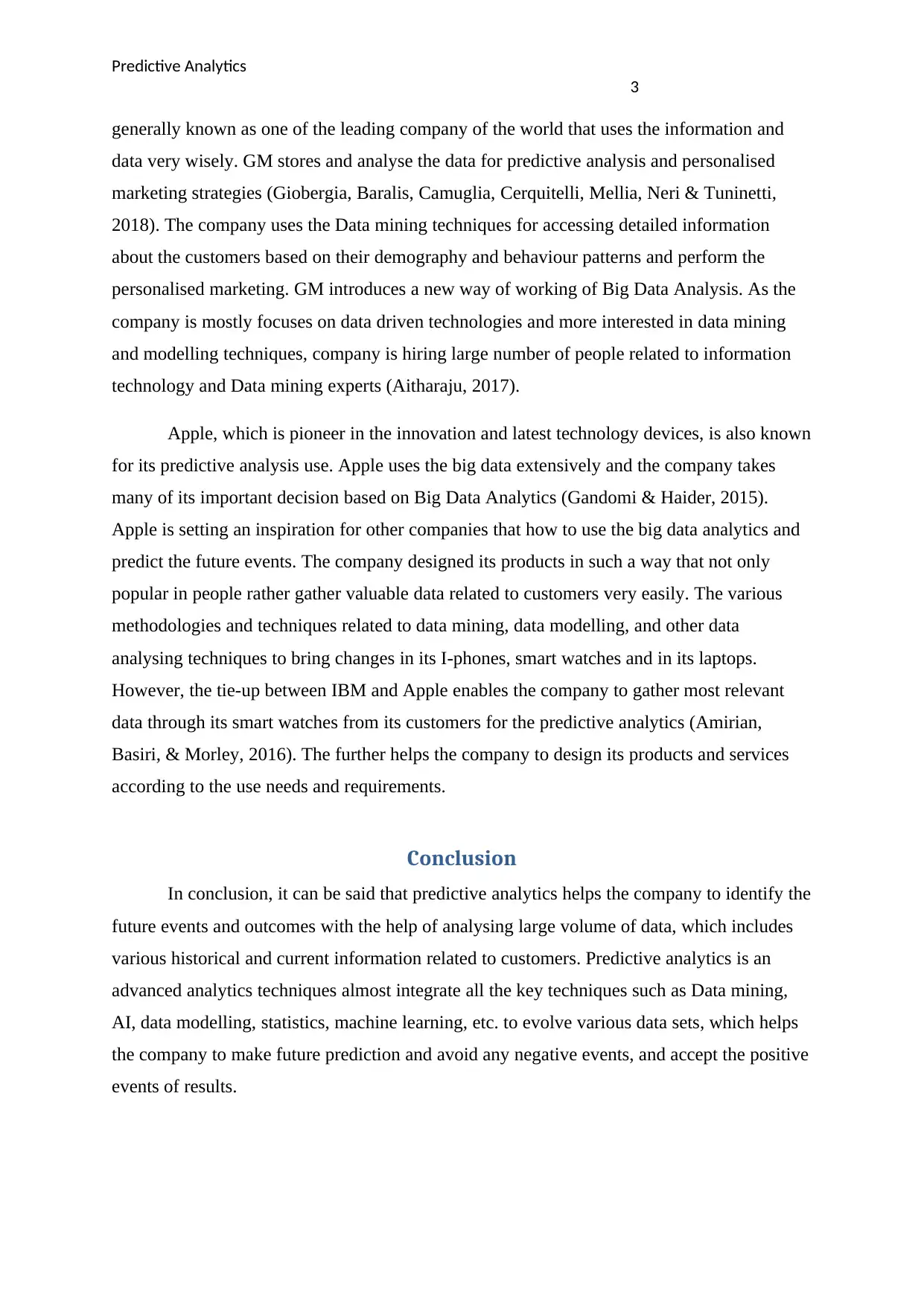
Predictive Analytics
3
generally known as one of the leading company of the world that uses the information and
data very wisely. GM stores and analyse the data for predictive analysis and personalised
marketing strategies (Giobergia, Baralis, Camuglia, Cerquitelli, Mellia, Neri & Tuninetti,
2018). The company uses the Data mining techniques for accessing detailed information
about the customers based on their demography and behaviour patterns and perform the
personalised marketing. GM introduces a new way of working of Big Data Analysis. As the
company is mostly focuses on data driven technologies and more interested in data mining
and modelling techniques, company is hiring large number of people related to information
technology and Data mining experts (Aitharaju, 2017).
Apple, which is pioneer in the innovation and latest technology devices, is also known
for its predictive analysis use. Apple uses the big data extensively and the company takes
many of its important decision based on Big Data Analytics (Gandomi & Haider, 2015).
Apple is setting an inspiration for other companies that how to use the big data analytics and
predict the future events. The company designed its products in such a way that not only
popular in people rather gather valuable data related to customers very easily. The various
methodologies and techniques related to data mining, data modelling, and other data
analysing techniques to bring changes in its I-phones, smart watches and in its laptops.
However, the tie-up between IBM and Apple enables the company to gather most relevant
data through its smart watches from its customers for the predictive analytics (Amirian,
Basiri, & Morley, 2016). The further helps the company to design its products and services
according to the use needs and requirements.
Conclusion
In conclusion, it can be said that predictive analytics helps the company to identify the
future events and outcomes with the help of analysing large volume of data, which includes
various historical and current information related to customers. Predictive analytics is an
advanced analytics techniques almost integrate all the key techniques such as Data mining,
AI, data modelling, statistics, machine learning, etc. to evolve various data sets, which helps
the company to make future prediction and avoid any negative events, and accept the positive
events of results.
3
generally known as one of the leading company of the world that uses the information and
data very wisely. GM stores and analyse the data for predictive analysis and personalised
marketing strategies (Giobergia, Baralis, Camuglia, Cerquitelli, Mellia, Neri & Tuninetti,
2018). The company uses the Data mining techniques for accessing detailed information
about the customers based on their demography and behaviour patterns and perform the
personalised marketing. GM introduces a new way of working of Big Data Analysis. As the
company is mostly focuses on data driven technologies and more interested in data mining
and modelling techniques, company is hiring large number of people related to information
technology and Data mining experts (Aitharaju, 2017).
Apple, which is pioneer in the innovation and latest technology devices, is also known
for its predictive analysis use. Apple uses the big data extensively and the company takes
many of its important decision based on Big Data Analytics (Gandomi & Haider, 2015).
Apple is setting an inspiration for other companies that how to use the big data analytics and
predict the future events. The company designed its products in such a way that not only
popular in people rather gather valuable data related to customers very easily. The various
methodologies and techniques related to data mining, data modelling, and other data
analysing techniques to bring changes in its I-phones, smart watches and in its laptops.
However, the tie-up between IBM and Apple enables the company to gather most relevant
data through its smart watches from its customers for the predictive analytics (Amirian,
Basiri, & Morley, 2016). The further helps the company to design its products and services
according to the use needs and requirements.
Conclusion
In conclusion, it can be said that predictive analytics helps the company to identify the
future events and outcomes with the help of analysing large volume of data, which includes
various historical and current information related to customers. Predictive analytics is an
advanced analytics techniques almost integrate all the key techniques such as Data mining,
AI, data modelling, statistics, machine learning, etc. to evolve various data sets, which helps
the company to make future prediction and avoid any negative events, and accept the positive
events of results.
Paraphrase This Document
Need a fresh take? Get an instant paraphrase of this document with our AI Paraphraser
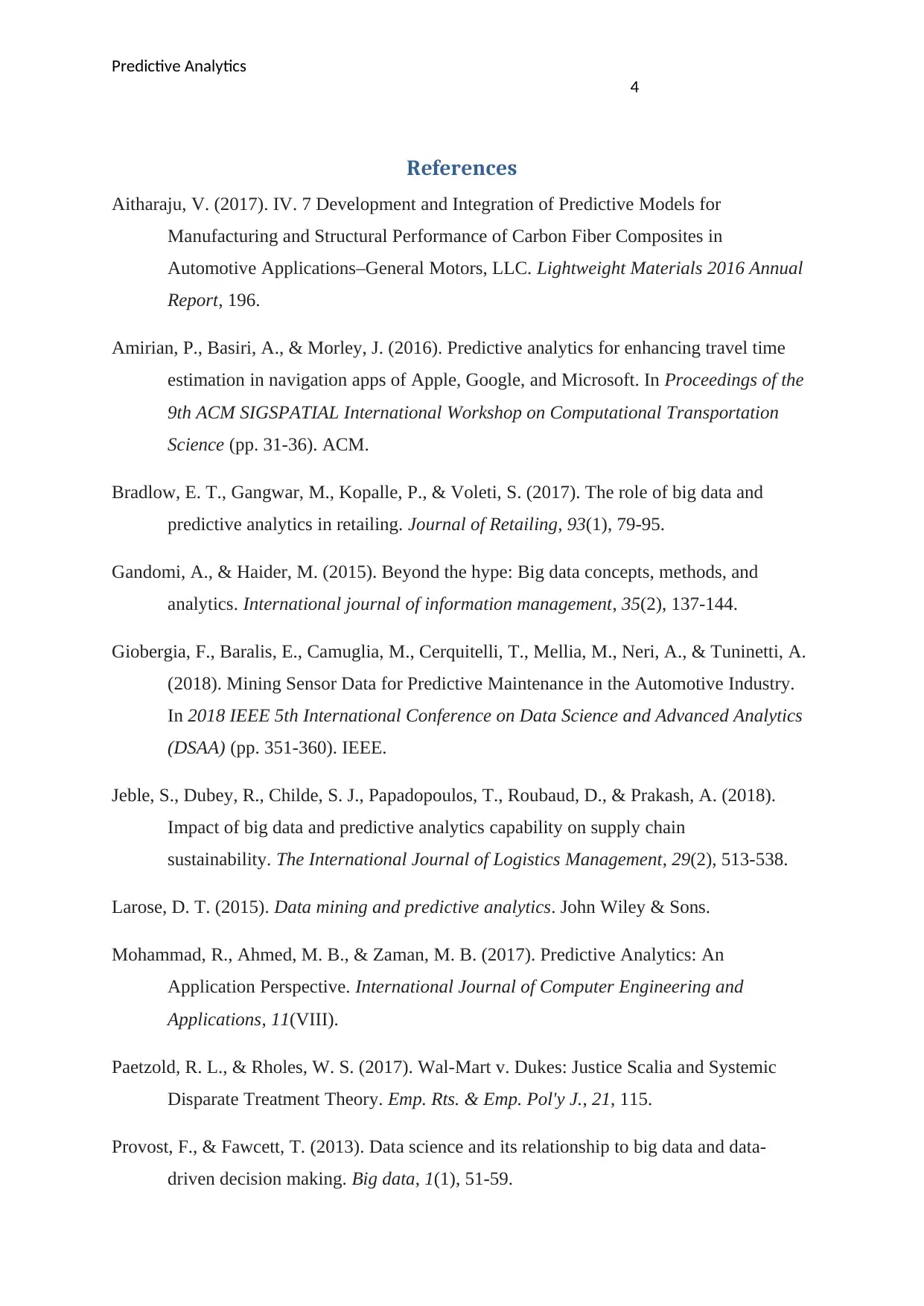
Predictive Analytics
4
References
Aitharaju, V. (2017). IV. 7 Development and Integration of Predictive Models for
Manufacturing and Structural Performance of Carbon Fiber Composites in
Automotive Applications–General Motors, LLC. Lightweight Materials 2016 Annual
Report, 196.
Amirian, P., Basiri, A., & Morley, J. (2016). Predictive analytics for enhancing travel time
estimation in navigation apps of Apple, Google, and Microsoft. In Proceedings of the
9th ACM SIGSPATIAL International Workshop on Computational Transportation
Science (pp. 31-36). ACM.
Bradlow, E. T., Gangwar, M., Kopalle, P., & Voleti, S. (2017). The role of big data and
predictive analytics in retailing. Journal of Retailing, 93(1), 79-95.
Gandomi, A., & Haider, M. (2015). Beyond the hype: Big data concepts, methods, and
analytics. International journal of information management, 35(2), 137-144.
Giobergia, F., Baralis, E., Camuglia, M., Cerquitelli, T., Mellia, M., Neri, A., & Tuninetti, A.
(2018). Mining Sensor Data for Predictive Maintenance in the Automotive Industry.
In 2018 IEEE 5th International Conference on Data Science and Advanced Analytics
(DSAA) (pp. 351-360). IEEE.
Jeble, S., Dubey, R., Childe, S. J., Papadopoulos, T., Roubaud, D., & Prakash, A. (2018).
Impact of big data and predictive analytics capability on supply chain
sustainability. The International Journal of Logistics Management, 29(2), 513-538.
Larose, D. T. (2015). Data mining and predictive analytics. John Wiley & Sons.
Mohammad, R., Ahmed, M. B., & Zaman, M. B. (2017). Predictive Analytics: An
Application Perspective. International Journal of Computer Engineering and
Applications, 11(VIII).
Paetzold, R. L., & Rholes, W. S. (2017). Wal-Mart v. Dukes: Justice Scalia and Systemic
Disparate Treatment Theory. Emp. Rts. & Emp. Pol'y J., 21, 115.
Provost, F., & Fawcett, T. (2013). Data science and its relationship to big data and data-
driven decision making. Big data, 1(1), 51-59.
4
References
Aitharaju, V. (2017). IV. 7 Development and Integration of Predictive Models for
Manufacturing and Structural Performance of Carbon Fiber Composites in
Automotive Applications–General Motors, LLC. Lightweight Materials 2016 Annual
Report, 196.
Amirian, P., Basiri, A., & Morley, J. (2016). Predictive analytics for enhancing travel time
estimation in navigation apps of Apple, Google, and Microsoft. In Proceedings of the
9th ACM SIGSPATIAL International Workshop on Computational Transportation
Science (pp. 31-36). ACM.
Bradlow, E. T., Gangwar, M., Kopalle, P., & Voleti, S. (2017). The role of big data and
predictive analytics in retailing. Journal of Retailing, 93(1), 79-95.
Gandomi, A., & Haider, M. (2015). Beyond the hype: Big data concepts, methods, and
analytics. International journal of information management, 35(2), 137-144.
Giobergia, F., Baralis, E., Camuglia, M., Cerquitelli, T., Mellia, M., Neri, A., & Tuninetti, A.
(2018). Mining Sensor Data for Predictive Maintenance in the Automotive Industry.
In 2018 IEEE 5th International Conference on Data Science and Advanced Analytics
(DSAA) (pp. 351-360). IEEE.
Jeble, S., Dubey, R., Childe, S. J., Papadopoulos, T., Roubaud, D., & Prakash, A. (2018).
Impact of big data and predictive analytics capability on supply chain
sustainability. The International Journal of Logistics Management, 29(2), 513-538.
Larose, D. T. (2015). Data mining and predictive analytics. John Wiley & Sons.
Mohammad, R., Ahmed, M. B., & Zaman, M. B. (2017). Predictive Analytics: An
Application Perspective. International Journal of Computer Engineering and
Applications, 11(VIII).
Paetzold, R. L., & Rholes, W. S. (2017). Wal-Mart v. Dukes: Justice Scalia and Systemic
Disparate Treatment Theory. Emp. Rts. & Emp. Pol'y J., 21, 115.
Provost, F., & Fawcett, T. (2013). Data science and its relationship to big data and data-
driven decision making. Big data, 1(1), 51-59.
1 out of 5
Related Documents
Your All-in-One AI-Powered Toolkit for Academic Success.
+13062052269
info@desklib.com
Available 24*7 on WhatsApp / Email
![[object Object]](/_next/static/media/star-bottom.7253800d.svg)
Unlock your academic potential
Copyright © 2020–2025 A2Z Services. All Rights Reserved. Developed and managed by ZUCOL.




